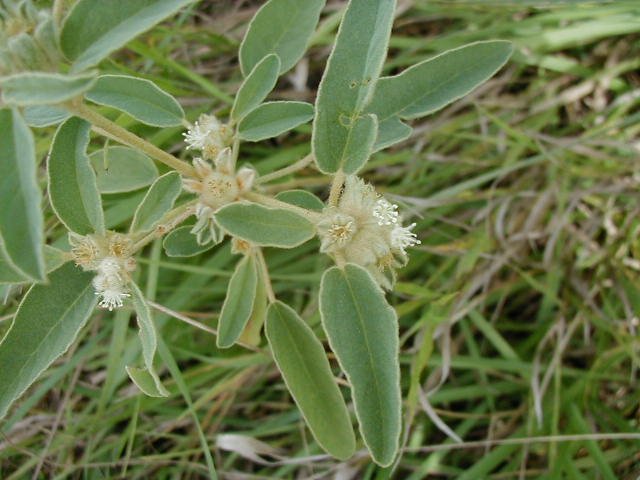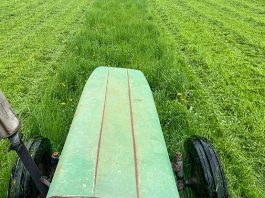 When I was in Grapevine, Texas for a conference several years ago, lots of folks asked me if they could use my training technique to teach cows to eat Woolly Croton. Woolly Croton (Croton capitatus) is also known as goat weed or dove weed, because dove, quail and turkeys love the seeds it produces. That means that hunters appreciate having this native, warm-season annual in pastures where they hope to hunt. But for folks raising livestock, it can be problematic. It can rapidly take over pastures that have been overgrazed or when other forages are stressed due to drought. Since there’s been a lot of drought recently, particularly in Texas, lots of graziers are trying to figure out what to do about the increasing populations of this plant.
When I was in Grapevine, Texas for a conference several years ago, lots of folks asked me if they could use my training technique to teach cows to eat Woolly Croton. Woolly Croton (Croton capitatus) is also known as goat weed or dove weed, because dove, quail and turkeys love the seeds it produces. That means that hunters appreciate having this native, warm-season annual in pastures where they hope to hunt. But for folks raising livestock, it can be problematic. It can rapidly take over pastures that have been overgrazed or when other forages are stressed due to drought. Since there’s been a lot of drought recently, particularly in Texas, lots of graziers are trying to figure out what to do about the increasing populations of this plant.
There are a variety of websites that list this plant as poisonous to livestock. However, after looking at the literature available I’ve found nothing to support these claims. But while it may not be poisonous, Croton species do contain chemicals (toxins) that can cause issues. For example, people once used the oils distilled from an Old World species of this plant, Croton tiglium, as a laxative. That use has since been discontinued because the oil was very potent and as little as 20 drops could be lethal. According to “Poisonous Plants of North America” (Burrows and Tyrl), crotons in North America contain similar chemicals, and these can cause stomach irritation and/or diarrhea.
Even that doesn’t make it inedible. Research has demonstrated that animals eat plants that are nutritious and simply reduce the amount they eat in response to the chemicals they contain. Additional research shows us that toxins and nutrients can offset the effects of other toxins and that if animals have a variety of forages to choose from they can mix a safe diet. I’ve seen this at work with cows I trained to eat weeds in Boulder, Colorado. After learning to eat late-season diffuse knapweed and dalmatian toadflax, they went on to eat a little of everything in their pasture, including plains milkweed (Asclepias pumila). According to Anthony Knight, author of A Guide to Plant Poisonings of Animals in North America this little flower has a cardiac glycoside which can harm animals if they eat too much. But since my herd had so much to choose from, they ate only a little of this plant and suffered no negative consequences.

All this background information is what I gave to a Texas rancher interested in teaching his cows to eat Woolly Croton. When I ran into him at another conference later on, he said he had used my training process to teach his cattle to eat it. He had found that they would eat it when they were in management-intensive grazing situations, but when they were allowed to graze at low stock densities, they ate much less of the plant. This tells us that it is possible for our cattle to eat it, but it’s not their favorite thing, indicating to me that we need to be sure they have variety in order to be most successful.
Here’s What I Would Do
There are two possibilities for getting cattle to eat this plant. First, if I had another weedy plant in the pasture, I might teach them to eat that one first and then let them try the Woolly Croton on their own. (Head over here for information about the training process.)
For example, if I had Canada thistle, or any other thistle for that matter, I’d teach the cattle to eat that because thistles are very nutritious and cows learn to eat them very easily. After learning to eat one weed, cattle begin to look at the plants in their pasture differently, and they always go on to add other plants as well. I’d watch to see if they decided to add Woolly Croton, visiting the pasture and looking closely at the Woolly Croton plants for evidence of being bitten off, or that they were missing parts of leaves, etc. If the cows didn’t try it, I would bring out the training tubs, place them near the Woolly Croton, cut a few and put them in the tubs to show the cattle that the plant is “good food.” Typically when I do this, the cattle begin adding the new weed to their diet quite quickly.
The second possibility is to train cattle to eat Woolly Croton itself. If you choose to do this, be sure that your cattle are in a pasture with plenty of variety and that they’re getting plenty to eat. Then, as you start to feed them the Woolly Croton, pay attention to how much they eat, and watch for diarrhea. I think that nothing will happen because they will be eating such a small amount.
Continue to pay attention to their health as they go on to graze it in pasture, always making sure they have plenty of variety. Typically, the amount of weedy plants animals eat is small at first, but grows over time. So just be patient and watch.
YOU ARE RESPONSIBLE FOR THE HEALTH AND SAFETY OF YOUR ANIMALS.
Train yourself before you train animals.
I’ve put together lots of resources for would-be trainers, including many On Pasture articles and a Youtube channel with videos.
Even better, purchase and download the Cows Eat Weeds ebook set.
 In Cows Eat Weeds I include all the background you need, along with problems and their solutions from my decade of actively working in the field training livestock across the U.S. and Canada to eat a wide variety of weeds. With it, you get Edible Weeds & Training Recipe. It’s a list of over 120 weeds I’ve either trained animals to eat, or I’ve looked up for graziers along with information on their safety as forage. The “Recipe” takes you through the training process step by step so you can get going quickly.
In Cows Eat Weeds I include all the background you need, along with problems and their solutions from my decade of actively working in the field training livestock across the U.S. and Canada to eat a wide variety of weeds. With it, you get Edible Weeds & Training Recipe. It’s a list of over 120 weeds I’ve either trained animals to eat, or I’ve looked up for graziers along with information on their safety as forage. The “Recipe” takes you through the training process step by step so you can get going quickly.
NEVER TRAIN YOUR ANIMALS TO EAT AN UNSAFE PLANT.
If you don’t know, download the ebooks above. If you don’t see your weed, email me your plant’s scientific name. I’ll check it out for you.
Never put animals in a solid stand of any plant.
All plants contain toxins. It is the dose that can cause illness or death. A variety of forages in pasture can prevent overdosing on any one thing.
Let animals start slowly to adjust to new foods.
It takes time for rumen microbes to adjust to new plants. This is especially true for plants that are nitrate accumulators where rumen microbes adjust over a period of five to seven days.
Don’t put hungry animals into a new pasture.
Think of what happens when you’re hungry and grocery shopping. You tend to buy things you shouldn’t. Hungry, thirsty animals are just like that. They don’t make good choices.
This rule is especially true for pastures largely made up of nitrate accumulating plants. Make sure that they have a full-stomach when moving to a new pasture with large stands of things like Canada thistle or pigweed. This will ensure that they have the necessary carbohydrates in their rumen to aid the rumen microbes in breaking down nitrate. I’ve include more information on why this is in the Cows Eat Weeds and Edible Weeds & Training Recipe Ebooks.
Does it all seem overwhelming?
I get that. I often feel overwhelmed when learning something new. Then I think about the end result – something I’m really looking forward to – and I breathe and then take it one step at a time. You can do this. I really tried to set it up so it could be possible for everyone because I want you to worry less about weeds and have more time for things you really enjoy.
Good luck! You can do it!





We manage 450 beef cattle on a Silvipastoril Project in Northern Guatemala, Peten. (Tropical rain forest area, our forest is of hardwood trees and is between 5-18 years old).
We are using natural pastures and bushes that grow under the tree canopy. Have no idea if the name of the pastures or bushes. Which is the best process to follow so that we can identify and analyze pasture and bush ?
Best regards,
Ricardo
Comments are closed.